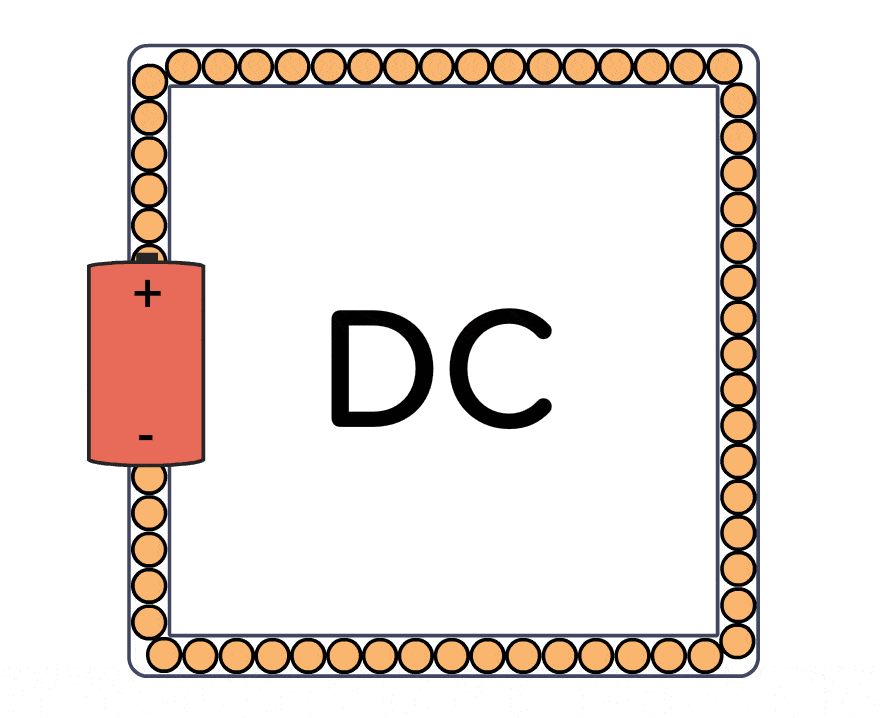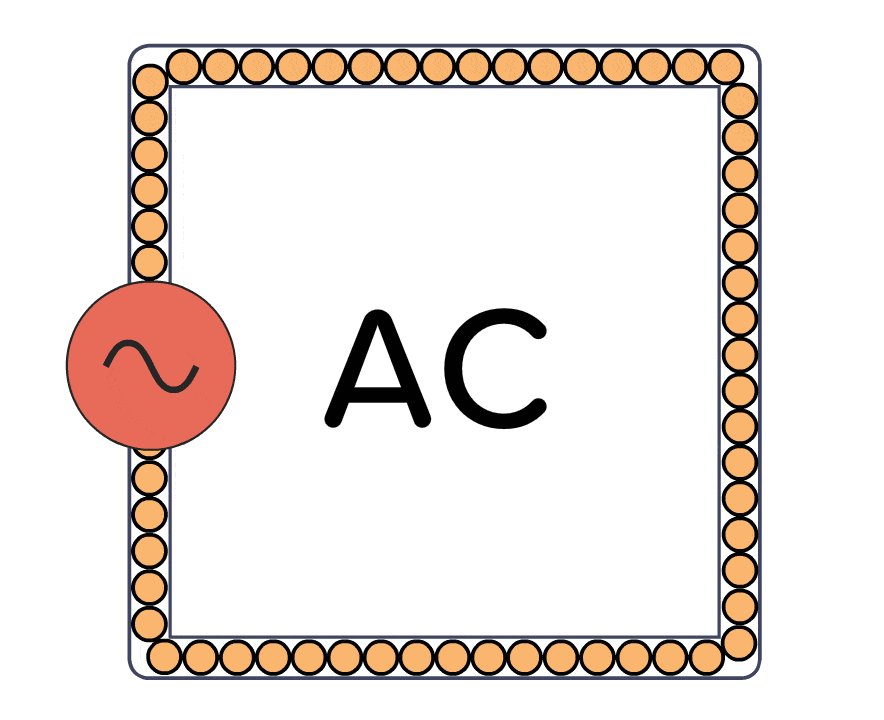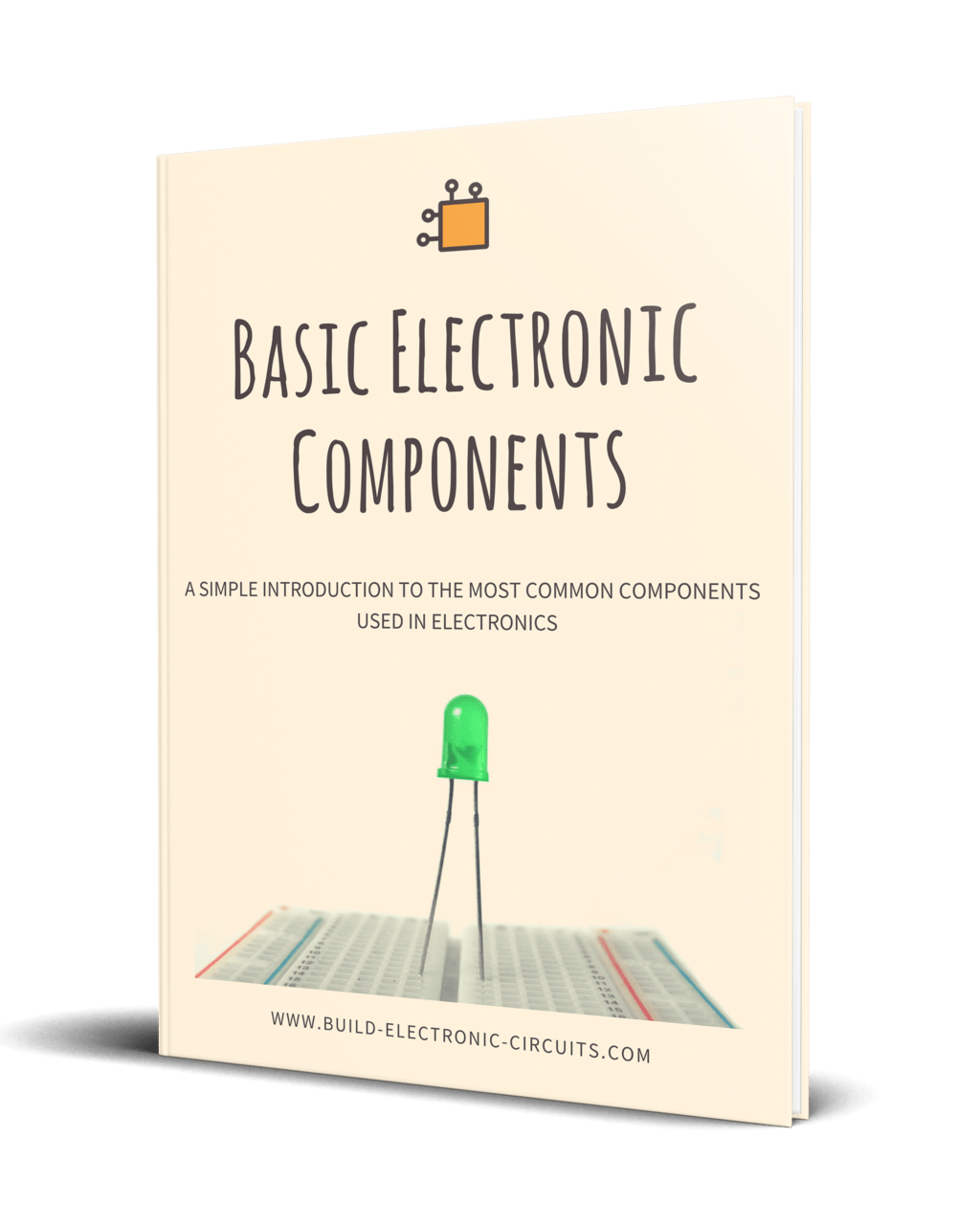The difference between Alternating Current (AC) and Direct Current (DC) is simple: AC vs DC comes down to how the current flows. AC is a current that alternates its direction. It goes back and forth continuously. DC is a current that flows in one direction.
Current flow in a DC circuit:

For example, a battery provides direct current. The current only flows one way out of a battery.
The current flow in an AC circuit:

In your wall sockets, you have AC. The current keeps changing direction about 50 to 60 times per second. But for many things, you have adapters that convert it into DC before it is used by a circuit.
(Although, it could as well have been DC in our walls if Edison had won the AC vs DC war back in the late 1800s against Tesla.)
AC vs DC in circuits
You usually need DC to power most things in electronics. I’ve never had the need for a power supply that outputs AC.
But you might find that you have AC in parts of your circuit. For example in audio circuits, radio circuits, or in power supplies.
The AC part is usually either a signal that represents something, like sound. Or an oscillating voltage to send a signal out into the field, like a radio transmitter.
Learn Electronics
If you’re looking to learn electronics, I recommend you focus on learning DC circuits. Knowing what AC is, is great to know. But most of the AC circuit lessons I’ve seen out there are focused on mathematical formulas – and don’t need it until you get to a more advanced level in electronics.

Get Our Basic Electronic Components Guide
Learn how the basic electronic components work so that circuit diagrams will start making sense to you.
If you want to learn electronics from scratch, you’re invited to join us over at Ohmify. With more than 300 lessons to choose from and a friendly community of like-minded people to help you. And at the Ohmify forum, no question is too basic.
What are your biggest questions when it comes to AC vs DC? Let me know in the comments below.
More Power Supplies Tutorials

Get Our Basic Electronic Components Guide
Learn how the basic electronic components work so that circuit diagrams will start making sense to you.

This is great and the diagrams need to be further fleshed ot and not just in a single line format. A lot of people think of a circuit as a single electron train going through the wire. No it is “pressure” from one to the next like a train of cars. The same thing with AC and this took a while for me to get my hands around but once understood then you know what neutral does.
This is all pressure not a real flow. Voltage is pressure!
And now scientists are talking about the electrons in copper as pseudo electromagnetic particles (they are not part of a photon in copper or other conductor). You do have free range electrons such as lightening.
Science has really progressed!
This video also has an interesting information about Alternating current and Direct current.
https://mega.nz/#!Q6RQharK!VukO-8fgA7C-8hjDeDNucFq1tFchM8KnV8Cb3T-x1rY
The DC animation is a bit misleading as it looks like the battery is spewing electrons into an empty tube. And it looks like the current becomes lower throughout the circuit. But in reality, the “tube”, or the wire, is always filled with electrons, even when no current is present. And the current is always the same everywhere in the circuit.
I am sorry but I do not completely agree with you, current is not always the same everywhere in the circuit. The farther the current (Number of electrons flowing past a point in a circuit) goes through a conductive wire, the more it decreases due to the resistance present in the wire.
Check this video out.
https://mega.nz/#!Jv5FiK4D!CNzwkgE6GfmiEAilB7KKMlHbeBZu3DE3h4-08NO2itw
This is what I learnt from these two videos especially from you.
That’s a common misconception. But you don’t have to take my word for it. Just get yourself a multimeter and try measuring the current coming out from the battery on the plus side and compare it to the current going back into the battery on the minus side. It’s the same. You can add as much resistance as you want in between. The current is the same in the beginning and in the end. A resistance (either in a wire or from a resistor) will reduce the current in the whole circuit.
Voltage, on the other hand, will drop across the resistive elements throughout the circuit.
Note that this is for series circuits where the current only have one path to take. If you add more paths, the current will divide into the different paths, but if you measure the current going out from the battery at the plus side and compare it with the current going back into the battery on the minus side, you’ll see that it’s the same no matter how complex your circuit is.
Does this mean that in the second video I posted, It is shown that each light bulb is producing different amount of light but in reality all the light bulbs will produce the same amount of light. I guess your answer is yes as I have just built and tested a series circuit on a breadboard using leds and a resistor and I came to know that the video explaination is wrong.
In that video, the lights were connected in parallel. So there are multiple paths for the current to flow. With 0 ohms resistance in the wires, and equal resistance in every light, they would light up equally.
But lights connected in parallel, with resistance in the wires between them (like you will have in long wires shown in the video), they will have a voltage drop in the wires. So you no longer have a series connection, but a mix of parallel and series-connected components. The current will be different depending on which path you’re in.
But the current will be the same if you compare the starting path and the ending path. So you still have the same current going into the circuit as you have going out.
Looking to build off grid. Will have year round running water for small hydro 12vDC system. Would like to learn power supplies and how to bypass or modify them to work 12v.
Such as a PC should be easy, power supply converts to 12v and 5v DC. What about a flat-screen? Is it simular to a PC. How about my synthesizer for my electric drums? ( I also have acoustic/analog drums, always work evev with no power)
Also was wondering if an inverter from 12v for brief use (power tools) or continuous use (like a freezer) could Benifit frome a capacitor for motor startup (like a hot start for an old Air-conditioner)
Ex: a fifty ft cord for up to 15/20 amps, DC, then a capacitor bank, (hot start) then your inverter is hooked to power tool freezer?
“Seek the all thy days knowledge, and in thy seeking, get wisdom”
I recommend you learn about voltage regulators. With those, you can easily convert your 12V DC source to other DC voltages, both higher and lower than 12V.
And yes, capacitors can be used to get a boost of current at startup.